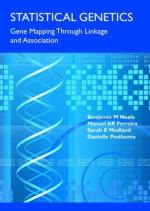|
This section contains 1,454 words (approx. 5 pages at 300 words per page) |

|
Linkage refers to the association and co-inheritance of two DNA segments because they reside close together on the same chromosome. Recombination is the process by which they become separated during crossing over, which occurs during meiosis. The existence of linkage and the frequency of recombination allow chromosomes to be mapped to determine the relative positions and distances of the genes and other DNA sequences on them. Linkage analysis is also a key tool for discovering the location and ultimate identity of genes for inherited diseases.
 Physical linkage of genes simply means they are on the same chromosome. To be genetically linked, a pair of genes must be close enough that they are unlikely to be separated by crossing over.
Physical linkage of genes simply means they are on the same chromosome. To be genetically linked, a pair of genes must be close enough that they are unlikely to be separated by crossing over.
Basic Concepts
Each individual inherits a complete set of twenty-three chromosomes from each parent, and chromosomes are therefore present in homologous pairs. The members of...
|
This section contains 1,454 words (approx. 5 pages at 300 words per page) |

|


